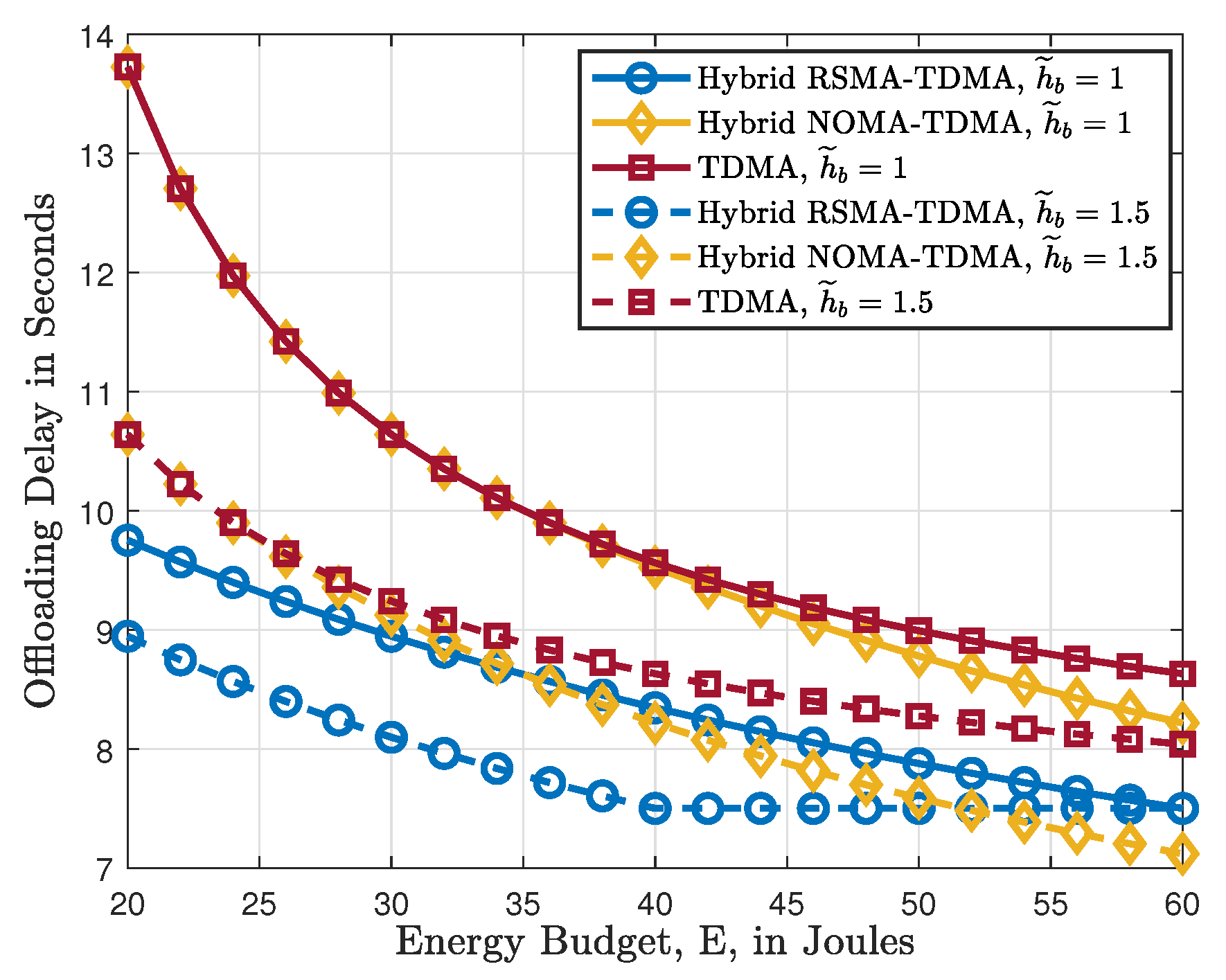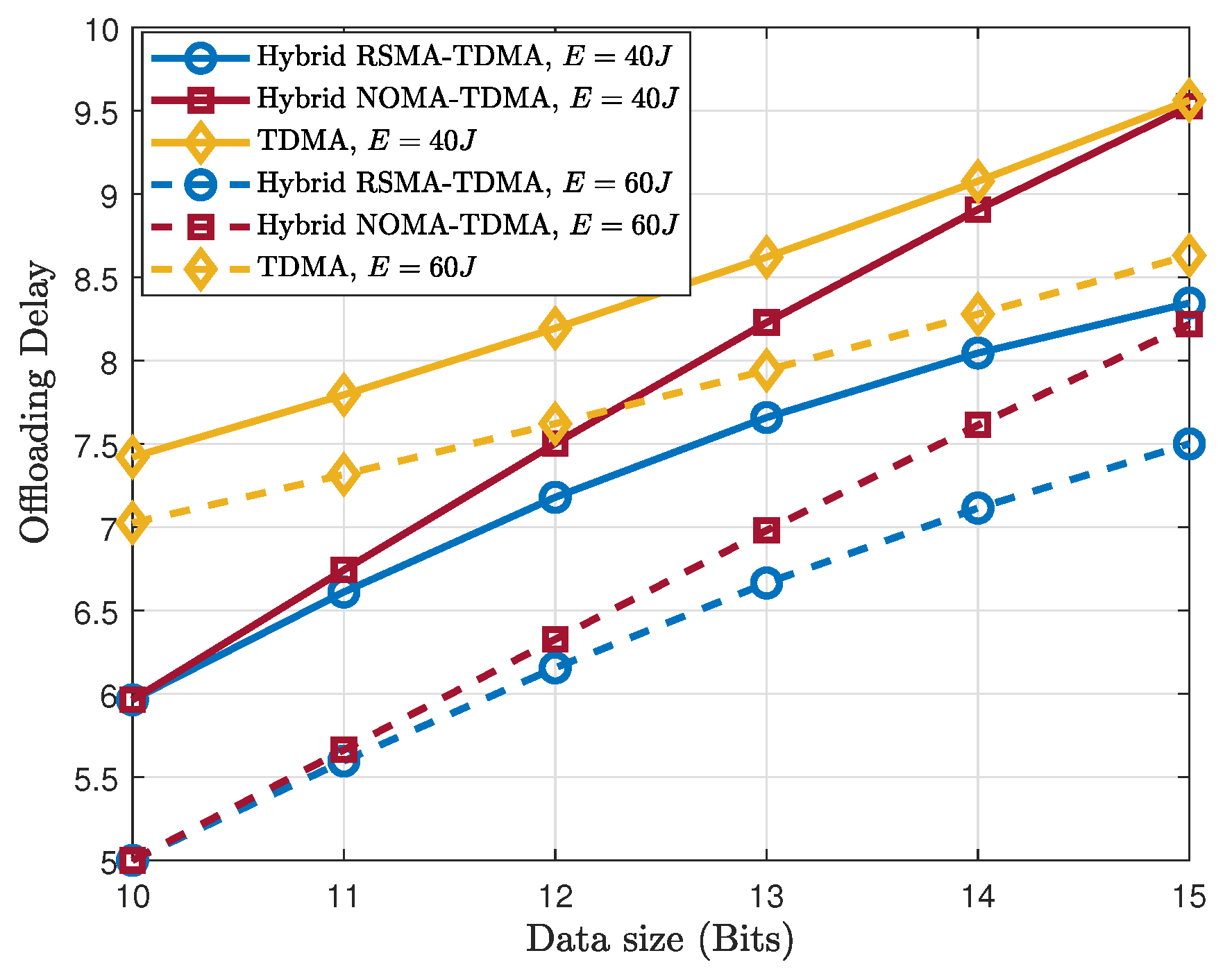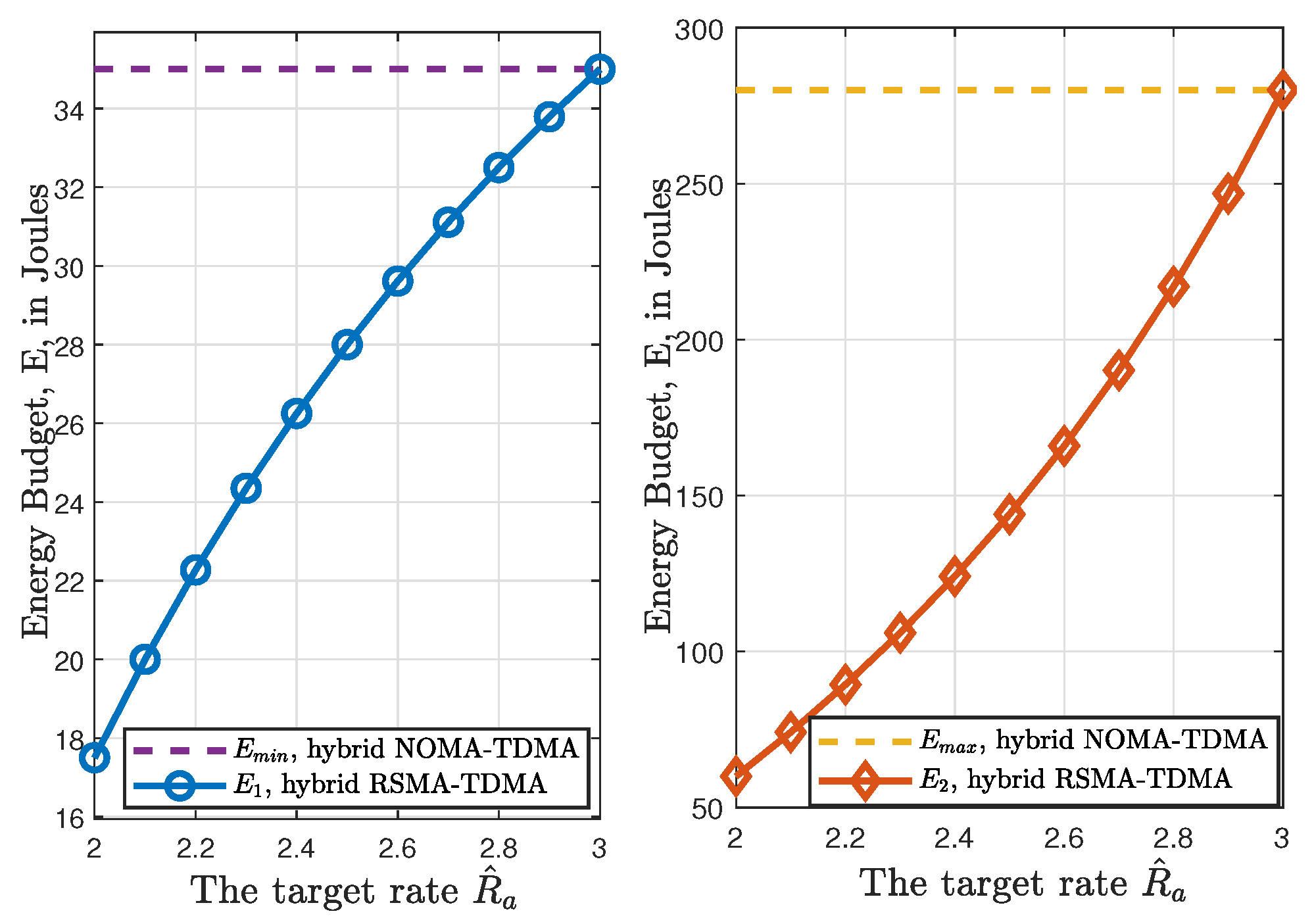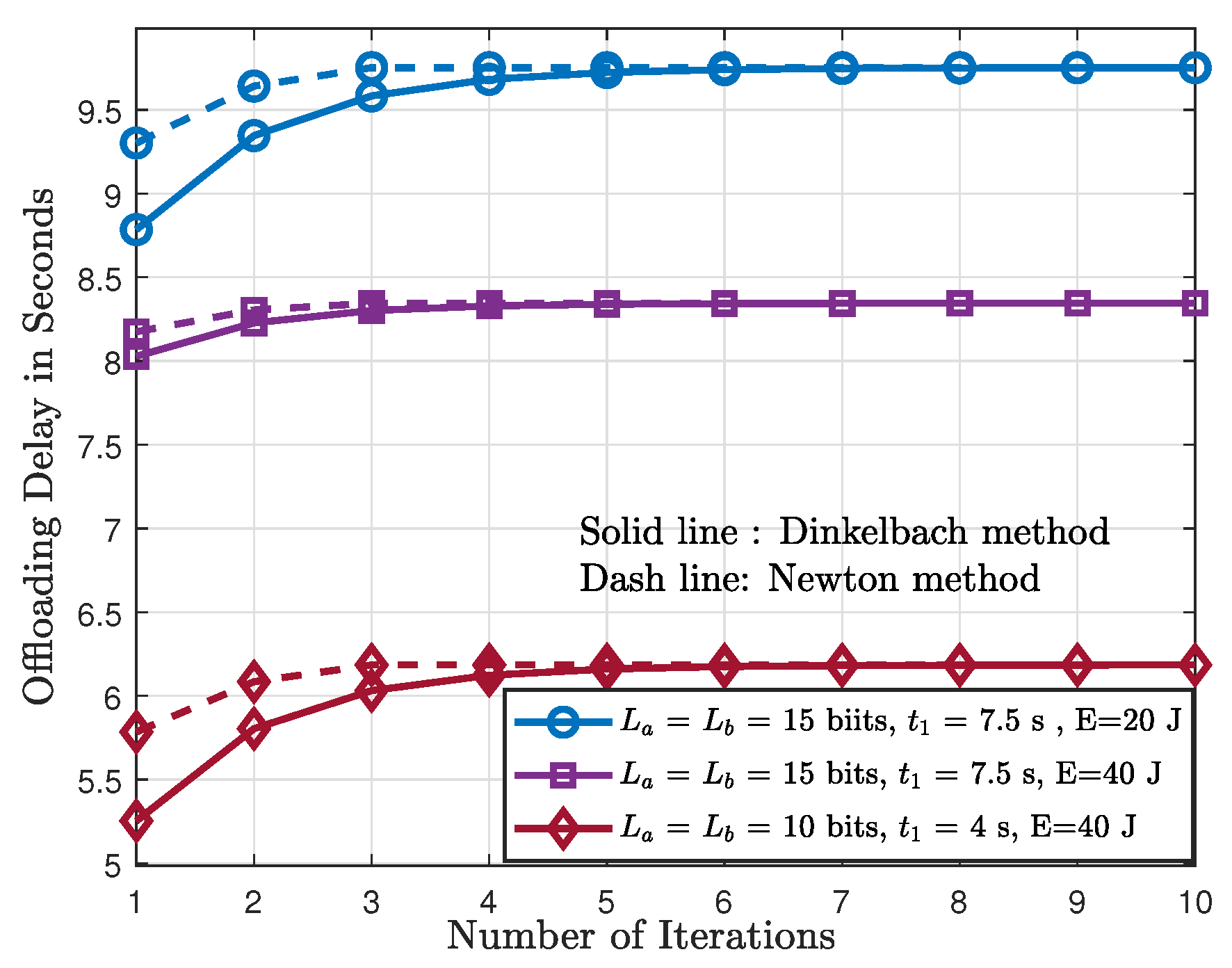Delay Minimization Using Hybrid RSMA-TDMA for Mobile Edge Computing
Abstract
1. Introduction
- We propose a hybrid RSMA-TDMA scheme to assist MEC with task offloading. In the proposed scheme, the offloading phase is divided into two phases. In the first phase, two edge users utilize the CR-inspired RSMA scheme to offload their computation tasks to a MEC server, while the second phase is allocated to a single user for task offloading. Specifically, If one user also has remaining computation tasks, the user will occupy an independent time phase for task offloading.
- We formulate an offloading delay minimization problem for a hybrid RSMA-TDMA scheme. Subject to the user’s different energy budget, three offloading scenarios are considered, i.e., TDMA, hybrid RSMA-TDMA, and RSMA. In the hybrid RSMA-TDMA, we develop an iterative algorithm by approximating the original problem into a convex one with Dinkelbachs’ method. The power allocation expressions of two phases are derived by Karush–Kuhn–Tucker (KKT) conditions.
- Numerous results reveal the superiority of the proposed hybrid RSMA-TDMA scheme compared with other schemes. Particularly, in the proposed scheme, with the increased target rate of PU, the chosen hybrid RSMA-TDMA scheme will become a hybrid NOMA-TDMA scheme.
2. System Model and CR-inspired RSMA Scheme
2.1. System Model
2.2. CR-Inspired RSMA Scheme
3. Offloading Delay Minimization
3.1. Case 1:
3.2. Case 2:
| Algorithm 1 Power allocation algorithm-based Dinkelbach iterative method |
|
| Algorithm 2 Power allocation algorithm based Newton iterative method |
|
3.3. Case 3:
4. Numerical Results
5. Conclusions
Author Contributions
Funding
Institutional Review Board Statement
Informed Consent Statement
Data Availability Statement
Acknowledgments
Conflicts of Interest
Appendix A
References
- Iwai, T.; Nakao, A. Demystifying Myths of MEC: Rethinking and Exploring Benefits of Multi-Access/Mobile Edge Computing. In Proceedings of the 2018 IEEE 7th International Conference on Cloud Networking (CloudNet), Tokyo, Japan, 22–24 October 2018; pp. 1–4. [Google Scholar]
- Wang, H.; Lv, T.; Lin, Z.; Zeng, J. Energy-Delay Minimization of Task Migration Based on Game Theory in MEC-Assisted Vehicular Networks. IEEE Trans. Veh. Technol. 2022, 71, 8175–8188. [Google Scholar] [CrossRef]
- Shirin Abkenar, F.; Ramezani, P.; Iranmanesh, S.; Murali, S.; Chulerttiyawong, D.; Wan, X.; Jamalipour, A.; Raad, R. A Survey on Mobility of Edge Computing Networks in IoT: State-of-the-Art, Architectures, and Challenges. IEEE Commun. Surv. Tuts. 2022, 24, 2329–2365. [Google Scholar] [CrossRef]
- Shirin Abkenar, F.; Iranmanesh, S.; Bouguettaya, A.; Raad, R.; Jamalipour, A. ENERGENT: An energy-efficient UAV-assisted fog-IoT framework for disaster management. J. Commun. Netw. 2022, 24, 698–709. [Google Scholar] [CrossRef]
- Altin, I.; Akar, M. Novel OMA and Hybrid NOMA Schemes for MEC Offloading. In Proceedings of the 2020 IEEE International Black Sea Conference on Communications and Networking (BlackSeaCom), Odessa, Ukraine, 26–29 May 2020; pp. 1–5. [Google Scholar]
- Kiani, A.; Ansari, N. Edge Computing Aware NOMA for 5G Networks. IEEE Internet Thing J. 2018, 5, 1299–1306. [Google Scholar] [CrossRef]
- Wan, Z.; Xu, D.; Xu, D.; Ahmad, I. Joint computation offloading and resource allocation for NOMA-based multi-access mobile edge computing systems. Comput. Netw. 2021, 196, 108256. [Google Scholar] [CrossRef]
- Chen, G.; Wu, Q.; Chen, W.; Ng, D.W.K.; Hanzo, L. IRS-Aided Wireless Powered MEC Systems: TDMA or NOMA for Computation Offloading? IEEE Trans. Wirel. Commun. 2023, 22, 1201–1218. [Google Scholar] [CrossRef]
- Ding, Z.; Ng, D.W.K.; Schober, R.; Poor, H.V. Delay Minimization for NOMA-MEC Offloading. IEEE Signal Process. Lett. 2018, 25, 1875–1879. [Google Scholar] [CrossRef]
- Liu, L.; Sun, B.; Wu, Y.; Tsang, D.H.K. Latency Optimization for Computation Offloading with Hybrid NOMA-OMA Transmission. IEEE Internet Thing J. 2021, 8, 6677–6691. [Google Scholar] [CrossRef]
- Zeng, M.; Nguyen, N.P.; Dobre, O.A.; Poor, H.V. Delay Minimization for NOMA-Assisted MEC Under Power and Energy Constraints. IEEE Wirel. Commun. Lett. 2019, 8, 1657–1661. [Google Scholar] [CrossRef]
- Zhou, F.; You, C.; Zhang, R. Delay-Optimal Scheduling for IRS-Aided Mobile Edge Computing. IEEE Wirel. Commun. Lett. 2021, 10, 740–744. [Google Scholar] [CrossRef]
- Li, H.; Fang, F.; Ding, Z. Joint resource allocation for hybrid NOMA-assisted MEC in 6G networks. Digit. Commun. Netw. 2020, 6, 241–252. [Google Scholar] [CrossRef]
- Mao, Y.; Dizdar, O.; Clerckx, B.; Schober, R.; Popovski, P.; Poor, H.V. Rate-Splitting Multiple Access: Fundamentals, Survey, and Future Research Trends. IEEE Commun. Surv. Tuts. 2022, 24, 2073–2126. [Google Scholar] [CrossRef]
- Xu, Y.; Mao, Y.; Dizdar, O.; Clerckx, B. Rate-Splitting Multiple Access With Finite Blocklength for Short-Packet and Low-Latency Downlink Communications. IEEE Trans. Veh. Technol. 2022, 71, 12333–12337. [Google Scholar] [CrossRef]
- Xiao, F.; Li, X.; Yang, L.; Liu, H.; Tsiftsis, T.A. Outage Performance Analysis of RSMA-Aided Semi-Grant-Free Transmission Systems. IEEE Open J. Commun. Soc. 2023, 4, 253–268. [Google Scholar] [CrossRef]
- Rimoldi, B.; Urbanke, R. A rate-splitting approach to the Gaussian multiple-access channel. IEEE Trans. Inf. Theory 1996, 42, 364–375. [Google Scholar] [CrossRef]
- Mao, Y.; Clerckx, B.; Li, V.O.K. Rate-splitting multiple access for downlink communication systems: Bridging, generalizing, and outperforming SDMA and NOMA. EURASIP J. Wirel. Commun. Netw. 2018, 2018, 133. [Google Scholar] [CrossRef] [PubMed]
- Clerckx, B.; Mao, Y.; Jorswieck, E.A.; Yuan, J.; Love, D.J.; Erkip, E.; Niyato, D. A Primer on Rate-Splitting Multiple Access: Tutorial, Myths, and Frequently Asked Questions. IEEE J. Select. Areas Commun. 2023, 41, 1265–1308. [Google Scholar] [CrossRef]
- Clerckx, B.; Mao, Y.; Schober, R.; Poor, H.V. Rate-Splitting Unifying SDMA, OMA, NOMA, and Multicasting in MISO Broadcast Channel: A Simple Two-User Rate Analysis. IEEE Wirel. Commun. Lett. 2020, 9, 349–353. [Google Scholar] [CrossRef]
- Jaafar, W.; Naser, S.; Muhaidat, S.; Sofotasios, P.C.; Yanikomeroglu, H. On the Downlink Performance of RSMA-Based UAV Communications. IEEE Trans. Veh. Technol. 2020, 69, 16258–16263. [Google Scholar] [CrossRef]
- Ye, Z.; Wang, X.; Zhang, Z.; Chen, X.; Yan, C. A rate-splitting non-orthogonal multiple access scheme for uplink transmission. In Proceedings of the International Conference on Wireless Communications & Signal Processing, Chennai, India, 22–24 March 2017. [Google Scholar]
- Liu, H.; Tsiftsis, T.A.; Kim, K.J.; Kwak, K.S.; Poor, H.V. Rate Splitting for Uplink NOMA with Enhanced Fairness and Outage Performance. IEEE Trans. Wirel. Commun. 2020, 19, 4657–4670. [Google Scholar] [CrossRef]
- Yang, Z.; Chen, M.; Saad, W.; Xu, W.; Shikh-Bahaei, M. Sum-Rate Maximization of Uplink Rate Splitting Multiple Access (RSMA) Communication. IEEE Trans. Mob. Comput. 2022, 21, 2596–2609. [Google Scholar]
- Truong, T.P.; Dao, N.N.; Cho, S. HAMEC-RSMA: Enhanced Aerial Computing Systems with Rate Splitting Multiple Access. IEEE Access 2022, 10, 52398–52409. [Google Scholar] [CrossRef]
- Liu, H.; Bai, Z.; Lei, H.; Pan, G.; Kim, K.J.; Tsiftsis, T.A. A New Rate Splitting Strategy for Uplink CR-NOMA Systems. IEEE Trans. Veh. Technol. 2022, 71, 7947–7951. [Google Scholar] [CrossRef]
- Liu, H.; Ye, Y.; Bai, Z.; Kim, K.J.; Tsiftsis, T.A. Rate Splitting Multiple Access Aided Mobile Edge Computing in Cognitive Radio Networks. In Proceedings of the 2022 IEEE International Conference on Communications Workshops (ICC Workshops), Seoul, Republic of Korea, 16–20 May 2022; pp. 598–603. [Google Scholar]
- Chen, P.; Liu, H.; Ye, Y.; Yang, L.; Kim, K.J.; Tsiftsis, T.A. Rate-Splitting Multiple Access Aided Mobile Edge Computing With Randomly Deployed Users. IEEE J. Select. Areas Commun. 2023, 41, 1549–1565. [Google Scholar] [CrossRef]
- Wang, F.; Xu, J.; Ding, Z. Optimized Multiuser Computation Offloading with Multi-Antenna NOMA. In Proceedings of the 2017 IEEE Globecom Workshops (GC Wkshps), Singapore, 4–8 December 2017; pp. 1–7. [Google Scholar]
- Sabuj, S.R.; Asiedu, D.K.P.; Lee, K.J.; Jo, H.S. Delay Optimization in Mobile Edge Computing: Cognitive UAV-Assisted eMBB and mMTC Services. IEEE Trans. Cogn. Commun. Netw. 2022, 8, 1019–1033. [Google Scholar] [CrossRef]
- Dinkelbach, W. On Nonlinear Fractional Programming. Manag. Sci. 1967, 13, 492–498. [Google Scholar] [CrossRef]





| [7] | [9] | [10] | [12] | [25] | [28] | Proposed Scheme | |
|---|---|---|---|---|---|---|---|
| NOMA scheme | ✓ | ✓ | ✓ | ✓ | |||
| RSMA scheme | ✓ | ✓ | ✓ | ||||
| Hybrid transmission scheme | ✓ | ✓ | ✓ | ✓ | |||
| Optimal power allocation | ✓ | ✓ | ✓ | ✓ | ✓ | ||
| Energy budget | ✓ | ✓ | ✓ | ||||
| Offloading delay minimization | ✓ | ✓ | ✓ | ✓ | ✓ |
| (a) Hybrid RSMA-TDMA scheme | ||||
| Energy Budget | Offloading Delay | |||
| 4.0851 | 11.0851 | 0.8446 | 40 | 8.3446 |
| 5.0413 | 12.0413 | 0.5971 | 45 | 8.0971 |
| 7.7988 | 14.7988 | 0.0344 | 59 | 7.5344 |
| (b) Hybrid NOMA-TDMA scheme | ||||
| Energy Budget | Offloading Delay | |||
| 0.8739 | 7.8739 | 4.5251 | 40 | 9.5251 |
| 1.7683 | 8.7683 | 4.1238 | 45 | 9.1238 |
| 4.3702 | 11.3702 | 3.2672 | 59 | 8.2672 |
Disclaimer/Publisher’s Note: The statements, opinions and data contained in all publications are solely those of the individual author(s) and contributor(s) and not of MDPI and/or the editor(s). MDPI and/or the editor(s) disclaim responsibility for any injury to people or property resulting from any ideas, methods, instructions or products referred to in the content. |
© 2023 by the authors. Licensee MDPI, Basel, Switzerland. This article is an open access article distributed under the terms and conditions of the Creative Commons Attribution (CC BY) license (https://creativecommons.org/licenses/by/4.0/).
Share and Cite
Xiao, F.; Chen, P.; Wu, H.; Mao, Y.; Liu, H. Delay Minimization Using Hybrid RSMA-TDMA for Mobile Edge Computing. Electronics 2023, 12, 2550. https://doi.org/10.3390/electronics12112550
Xiao F, Chen P, Wu H, Mao Y, Liu H. Delay Minimization Using Hybrid RSMA-TDMA for Mobile Edge Computing. Electronics. 2023; 12(11):2550. https://doi.org/10.3390/electronics12112550
Chicago/Turabian StyleXiao, Fengcheng, Pengxu Chen, Hua Wu, Yuming Mao, and Hongwu Liu. 2023. "Delay Minimization Using Hybrid RSMA-TDMA for Mobile Edge Computing" Electronics 12, no. 11: 2550. https://doi.org/10.3390/electronics12112550
APA StyleXiao, F., Chen, P., Wu, H., Mao, Y., & Liu, H. (2023). Delay Minimization Using Hybrid RSMA-TDMA for Mobile Edge Computing. Electronics, 12(11), 2550. https://doi.org/10.3390/electronics12112550





